| |
|
Troston is a
little-known village in the quiet lanes between Bury and
Diss, purposeful and pleasing, the church quietly grand
in what it must be said is a rather bleak churchyard,
entirely cleared of headstones by lawnmower enthusiasts
at some point. The porch is a bold, confident statement
of the late 15th century, with image niches, Marian
monograms and a dedicatory inscription in the flushwork.
As Pevsner points out, it is very similar to the porch at
nearby Honington, and so is perhaps the work of the same
masons.
St Mary is a complex building. The porch and Decorated
windows should not distract from the fact that the church
looked pretty much as it does now by 1300, when the tower
was added to the existing nave and earlier chancel. The
nave can seem gloomy as you step into it - we haven't
been prepared for gloom by an obviously Norman structure
as we are at Thornham Parva or Wissington. But as your
eyes become accustomed to the light, you realise you are
inside a church of outstanding interest, and, perhaps one
that is a little unusual, for the 19th Century
restoration was carried out by a local amateur architect
who just happened to be the patron of the living.
Robert Emlyn Lofft was the grandson of the 18th Century
radical lawyer and writer Capel Lofft, and he inherited
Troston Hall in 1866. His enthusiasm for architecture
extended not just to the church but to a number of
buildings in the parish which survive with their
idiosyncrasies, including the former village school.
Fortunately for us Lofft was an enthusiastic antiquarian,
and if the 19th Century patina of the interior is
inescapable there are still a number of quite remarkable
earlier survivals.
The most striking of these is Troston's fine group of
wall paintings. It would be wrong to call them a
sequence, for they are separate subjects from different
times and apparently by different hands. Most prominent
is the 15th century figure of St George on horseback,
dispatching a dragon. He is a fine figure, and you can
sense the force with which the lance is pushed home.
Roughly contemporary with him is a stately St
Christopher, familiar from a hundred other East Anglian
churches of course, but here with a gravitas he sometimes
lacks elsewhere.
There is another figure, a knight on horseback, who
appears to be forcing his lance into a dragon-shaped
space, almost certainly another St George. But the most
interesting thing about him is that he is older than the
two larger paintings, a reminder that wall paintings in
churches were successively covered and repainted as
artistic fashions and devotional priorities changed and
developed. In many places, we find that by the later
years of the 15th century they are being covered up, and
the walls are being punched through with large windows,
to illuminate the new arrangement of pulpit and benches,
and the great rood above the chancel arch - this, a full
half century before the Protestant Reformation.
The most memorable of the paintings here is perhaps the
excerpt from what appears to be a 14th century martyrdom
of St Edmund scheme. The saint leans back on a tree, his
body already pierced by arrows, his attackers looking on.
Troston is on the route between the probable site of that
martyrdom in Hellesdon near Norwich and the saint's final
resting place at Bury Abbey. These paintings are all on
the north wall, but above them all, over the chancel
arch, sits a 15th century Christ in Judgement, blood
spurting from his wounds.
  
 
As with many churches,
St Mary retains its low-side window. These were intended
to be opened for the sanctus bell rung at the
consecration of the Mass to be heard across the parish
outside, enabling those of the community at work in the
fields to pause and join in the contemplation of this
most sacred moment. But they were also probably a means
of controlling ventilation. The flicker that the
updraught of air would have given to the candles on the
rood loft above might not have been intended, but it
would certainly have been effective. Uniquely in Suffolk,
Troston retains the wooden shutter which the clerk would
open to ring the bell.
Also in the chancel,
St Mary retains the fixings for the Lenten veil, and the
Early English detailing of the south wall still suggests
something of the quiet mystery of medieval Catholicism
before the awe and wonder of the 15th century
Perpendicular mood made its impression on Suffolk
churches. The woodwork behind the altar was probably the
eastern parapet of the rood loft, a rare survival. But
the loveliest feature of the chancel is not medieval at
all. It is the 1964 east window, by Harry Stammers, and
it must rank among the finest of his work. It depicts the
story of Emmaus, the unrecognised Christ walking along
the road with his two companions, and then making himself
known to them above at the supper table in the breaking
of the bread.
  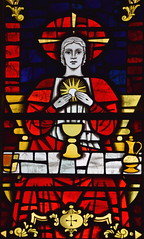  
 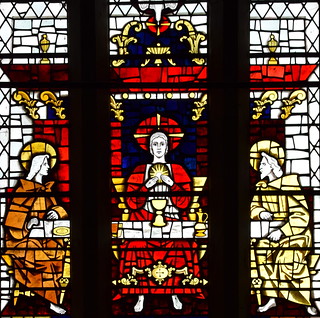
At the back of the
nave, the late medieval benches retain some carvings,
including a female figure kneeling at a prayer desk which
might have been part of an Annunciation. Certainly, she
is not a mermaid as I've seen recorded elsewhere. Other
woodwork includes the huge pulpit and reading desk, as
big as a family car parked at the east end of the nave.
It was cobbled together by Lofft in the 1860s, reusing a
pulpit from 250 years earlier.
The royal arms are lettered for George I, but they are
actually Stuart arms for James I as you can see from that
monarch's motto at the bottom, Exurgat Deus
Dissipentur Inimici, a cry from the Psalms for God
to rise up and disperse his enemies. Nearby, a memorial
plaque remembers Henry Capel Lloft, who honourably
fell in a most gallant charge on the French line in the
great battle of Albuhera in 1787. Heir to the Hall,
he was 28 years old.
As you can see, Troston church is an interesting and
unusual church which is not as well-known as many of
Suffolk's other churches. This is a church to savour,
hopefully in silence and solitude. Things here need to be
contemplated. It is a place to sit and wonder.
Simon
Knott, July 2019
Follow these journeys as they happen at Last Of England
Twitter.
 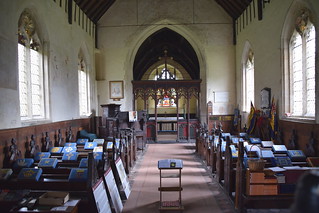 
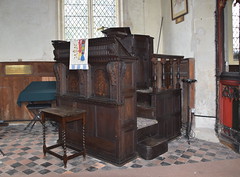   
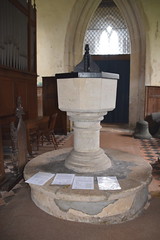 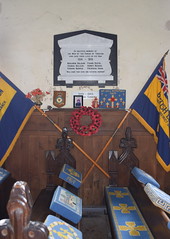   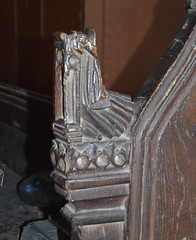
| |
| |
|
|
|
|
|
|
|
| |
|
|
|
|
|
|
|
|
The Churches of East
Anglia websites are
non-profit-making, in fact they
are run at a loss. But if you
enjoy using them and find them
useful, a small contribution
towards the costs of web space,
train fares and the like would be
most gratefully received. You can
donate via Paypal.
|
|
|
|
|
|
|
|
|
|
|
|
|
|
|
|
|
|
|
|
|
|
|
|
| |
|
|
|
|
|
|
|
|
|
|
|
|
|
|
|
|
|

